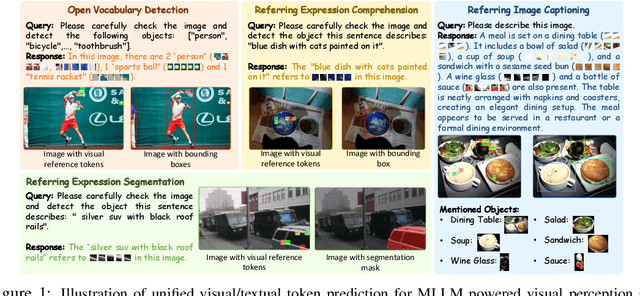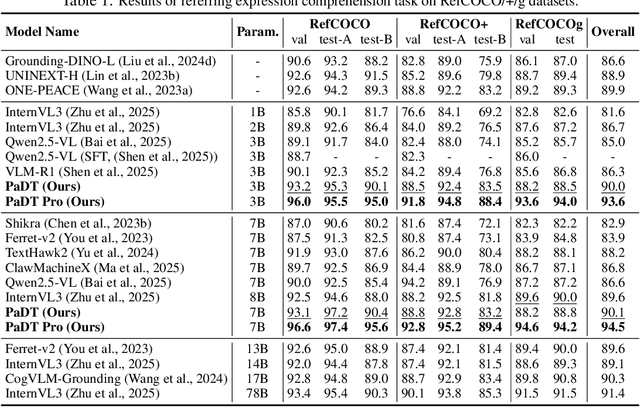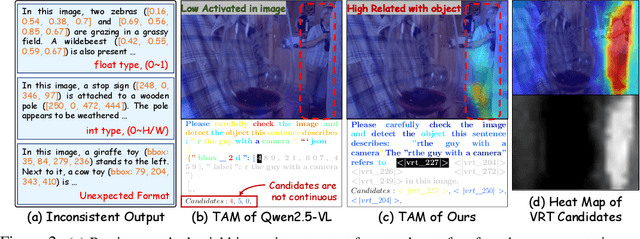Table Detection
Table detection is the process of identifying and extracting tables from documents or images.
Papers and Code
Hierarchical Sequence Iteration for Heterogeneous Question Answering
Oct 23, 2025Retrieval-augmented generation (RAG) remains brittle on multi-step questions and heterogeneous evidence sources, trading accuracy against latency and token/tool budgets. This paper introducesHierarchical Sequence (HSEQ) Iteration for Heterogeneous Question Answering, a unified framework that (i) linearize documents, tables, and knowledge graphs into a reversible hierarchical sequence with lightweight structural tags, and (ii) perform structure-aware iteration to collect just-enough evidence before answer synthesis. A Head Agent provides guidance that leads retrieval, while an Iteration Agent selects and expands HSeq via structure-respecting actions (e.g., parent/child hops, table row/column neighbors, KG relations); Finally the head agent composes canonicalized evidence to genearte the final answer, with an optional refinement loop to resolve detected contradictions. Experiments on HotpotQA (text), HybridQA/TAT-QA (table+text), and MetaQA (KG) show consistent EM/F1 gains over strong single-pass, multi-hop, and agentic RAG baselines with high efficiency. Besides, HSEQ exhibits three key advantages: (1) a format-agnostic unification that enables a single policy to operate across text, tables, and KGs without per-dataset specialization; (2) guided, budget-aware iteration that reduces unnecessary hops, tool calls, and tokens while preserving accuracy; and (3) evidence canonicalization for reliable QA, improving answers consistency and auditability.
Towards Cross-Modal Error Detection with Tables and Images
Oct 14, 2025Ensuring data quality at scale remains a persistent challenge for large organizations. Despite recent advances, maintaining accurate and consistent data is still complex, especially when dealing with multiple data modalities. Traditional error detection and correction methods tend to focus on a single modality, typically a table, and often miss cross-modal errors that are common in domains like e-Commerce and healthcare, where image, tabular, and text data co-exist. To address this gap, we take an initial step towards cross-modal error detection in tabular data, by benchmarking several methods. Our evaluation spans four datasets and five baseline approaches. Among them, Cleanlab, a label error detection framework, and DataScope, a data valuation method, perform the best when paired with a strong AutoML framework, achieving the highest F1 scores. Our findings indicate that current methods remain limited, particularly when applied to heavy-tailed real-world data, motivating further research in this area.
Multi-Stage Field Extraction of Financial Documents with OCR and Compact Vision-Language Models
Oct 27, 2025Financial documents are essential sources of information for regulators, auditors, and financial institutions, particularly for assessing the wealth and compliance of Small and Medium-sized Businesses. However, SMB documents are often difficult to parse. They are rarely born digital and instead are distributed as scanned images that are none machine readable. The scans themselves are low in resolution, affected by skew or rotation, and often contain noisy backgrounds. These documents also tend to be heterogeneous, mixing narratives, tables, figures, and multilingual content within the same report. Such characteristics pose major challenges for automated information extraction, especially when relying on end to end large Vision Language Models, which are computationally expensive, sensitive to noise, and slow when applied to files with hundreds of pages. We propose a multistage pipeline that leverages traditional image processing models and OCR extraction, together with compact VLMs for structured field extraction of large-scale financial documents. Our approach begins with image pre-processing, including segmentation, orientation detection, and size normalization. Multilingual OCR is then applied to recover page-level text. Upon analyzing the text information, pages are retrieved for coherent sections. Finally, compact VLMs are operated within these narrowed-down scopes to extract structured financial indicators. Our approach is evaluated using an internal corpus of multi-lingual, scanned financial documents. The results demonstrate that compact VLMs, together with a multistage pipeline, achieves 8.8 times higher field level accuracy relative to directly feeding the whole document into large VLMs, only at 0.7 percent of the GPU cost and 92.6 percent less end-to-end service latency.
Patch-as-Decodable-Token: Towards Unified Multi-Modal Vision Tasks in MLLMs
Oct 02, 2025



Multimodal large language models (MLLMs) have advanced rapidly in recent years. However, existing approaches for vision tasks often rely on indirect representations, such as generating coordinates as text for detection, which limits performance and prevents dense prediction tasks like segmentation. To overcome these challenges, we introduce Patch-as-Decodable Token (PaDT), a unified paradigm that enables MLLMs to directly generate both textual and diverse visual outputs. Central to PaDT are Visual Reference Tokens (VRTs), derived from visual patch embeddings of query images and interleaved seamlessly with LLM's output textual tokens. A lightweight decoder then transforms LLM's outputs into detection, segmentation, and grounding predictions. Unlike prior methods, PaDT processes VRTs independently at each forward pass and dynamically expands the embedding table, thus improving localization and differentiation among similar objects. We further tailor a training strategy for PaDT by randomly selecting VRTs for supervised fine-tuning and introducing a robust per-token cross-entropy loss. Our empirical studies across four visual perception and understanding tasks suggest PaDT consistently achieving state-of-the-art performance, even compared with significantly larger MLLM models. The code is available at https://github.com/Gorilla-Lab-SCUT/PaDT.
Predictive Modeling and Explainable AI for Veterinary Safety Profiles, Residue Assessment, and Health Outcomes Using Real-World Data and Physicochemical Properties
Oct 01, 2025The safe use of pharmaceuticals in food-producing animals is vital to protect animal welfare and human food safety. Adverse events (AEs) may signal unexpected pharmacokinetic or toxicokinetic effects, increasing the risk of violative residues in the food chain. This study introduces a predictive framework for classifying outcomes (Death vs. Recovery) using ~1.28 million reports (1987-2025 Q1) from the U.S. FDA's OpenFDA Center for Veterinary Medicine. A preprocessing pipeline merged relational tables and standardized AEs through VeDDRA ontologies. Data were normalized, missing values imputed, and high-cardinality features reduced; physicochemical drug properties were integrated to capture chemical-residue links. We evaluated supervised models, including Random Forest, CatBoost, XGBoost, ExcelFormer, and large language models (Gemma 3-27B, Phi 3-12B). Class imbalance was addressed, such as undersampling and oversampling, with a focus on prioritizing recall for fatal outcomes. Ensemble methods(Voting, Stacking) and CatBoost performed best, achieving precision, recall, and F1-scores of 0.95. Incorporating Average Uncertainty Margin (AUM)-based pseudo-labeling of uncertain cases improved minority-class detection, particularly in ExcelFormer and XGBoost. Interpretability via SHAP identified biologically plausible predictors, including lung, heart, and bronchial disorders, animal demographics, and drug physicochemical properties. These features were strongly linked to fatal outcomes. Overall, the framework shows that combining rigorous data engineering, advanced machine learning, and explainable AI enables accurate, interpretable predictions of veterinary safety outcomes. The approach supports FARAD's mission by enabling early detection of high-risk drug-event profiles, strengthening residue risk assessment, and informing regulatory and clinical decision-making.
Extracting Information from Scientific Literature via Visual Table Question Answering Models
Aug 26, 2025This study explores three approaches to processing table data in scientific papers to enhance extractive question answering and develop a software tool for the systematic review process. The methods evaluated include: (1) Optical Character Recognition (OCR) for extracting information from documents, (2) Pre-trained models for document visual question answering, and (3) Table detection and structure recognition to extract and merge key information from tables with textual content to answer extractive questions. In exploratory experiments, we augmented ten sample test documents containing tables and relevant content against RF- EMF-related scientific papers with seven predefined extractive question-answer pairs. The results indicate that approaches preserving table structure outperform the others, particularly in representing and organizing table content. Accurately recognizing specific notations and symbols within the documents emerged as a critical factor for improved results. Our study concludes that preserving the structural integrity of tables is essential for enhancing the accuracy and reliability of extractive question answering in scientific documents.
* Accepted at ACM International Conference on Research in Adaptive and Convergent Systems, November 5-8, 2024, Pompei, Italy
From Surface to Semantics: Semantic Structure Parsing for Table-Centric Document Analysis
Aug 14, 2025Documents are core carriers of information and knowl-edge, with broad applications in finance, healthcare, and scientific research. Tables, as the main medium for structured data, encapsulate key information and are among the most critical document components. Existing studies largely focus on surface-level tasks such as layout analysis, table detection, and data extraction, lacking deep semantic parsing of tables and their contextual associations. This limits advanced tasks like cross-paragraph data interpretation and context-consistent analysis. To address this, we propose DOTABLER, a table-centric semantic document parsing framework designed to uncover deep semantic links between tables and their context. DOTABLER leverages a custom dataset and domain-specific fine-tuning of pre-trained models, integrating a complete parsing pipeline to identify context segments semantically tied to tables. Built on this semantic understanding, DOTABLER implements two core functionalities: table-centric document structure parsing and domain-specific table retrieval, delivering comprehensive table-anchored semantic analysis and precise extraction of semantically relevant tables. Evaluated on nearly 4,000 pages with over 1,000 tables from real-world PDFs, DOTABLER achieves over 90% Precision and F1 scores, demonstrating superior performance in table-context semantic analysis and deep document parsing compared to advanced models such as GPT-4o.
Improving Narrative Classification and Explanation via Fine Tuned Language Models
Sep 04, 2025Understanding covert narratives and implicit messaging is essential for analyzing bias and sentiment. Traditional NLP methods struggle with detecting subtle phrasing and hidden agendas. This study tackles two key challenges: (1) multi-label classification of narratives and sub-narratives in news articles, and (2) generating concise, evidence-based explanations for dominant narratives. We fine-tune a BERT model with a recall-oriented approach for comprehensive narrative detection, refining predictions using a GPT-4o pipeline for consistency. For narrative explanation, we propose a ReACT (Reasoning + Acting) framework with semantic retrieval-based few-shot prompting, ensuring grounded and relevant justifications. To enhance factual accuracy and reduce hallucinations, we incorporate a structured taxonomy table as an auxiliary knowledge base. Our results show that integrating auxiliary knowledge in prompts improves classification accuracy and justification reliability, with applications in media analysis, education, and intelligence gathering.
Text to Query Plans for Question Answering on Large Tables
Aug 26, 2025Efficient querying and analysis of large tabular datasets remain significant challenges, especially for users without expertise in programming languages like SQL. Text-to-SQL approaches have shown promising performance on benchmark data; however, they inherit SQL's drawbacks, including inefficiency with large datasets and limited support for complex data analyses beyond basic querying. We propose a novel framework that transforms natural language queries into query plans. Our solution is implemented outside traditional databases, allowing us to support classical SQL commands while avoiding SQL's inherent limitations. Additionally, we enable complex analytical functions, such as principal component analysis and anomaly detection, providing greater flexibility and extensibility than traditional SQL capabilities. We leverage LLMs to iteratively interpret queries and construct operation sequences, addressing computational complexity by incrementally building solutions. By executing operations directly on the data, we overcome context length limitations without requiring the entire dataset to be processed by the model. We validate our framework through experiments on both standard databases and large scientific tables, demonstrating its effectiveness in handling extensive datasets and performing sophisticated data analyses.
Is this chart lying to me? Automating the detection of misleading visualizations
Aug 29, 2025Misleading visualizations are a potent driver of misinformation on social media and the web. By violating chart design principles, they distort data and lead readers to draw inaccurate conclusions. Prior work has shown that both humans and multimodal large language models (MLLMs) are frequently deceived by such visualizations. Automatically detecting misleading visualizations and identifying the specific design rules they violate could help protect readers and reduce the spread of misinformation. However, the training and evaluation of AI models has been limited by the absence of large, diverse, and openly available datasets. In this work, we introduce Misviz, a benchmark of 2,604 real-world visualizations annotated with 12 types of misleaders. To support model training, we also release Misviz-synth, a synthetic dataset of 81,814 visualizations generated using Matplotlib and based on real-world data tables. We perform a comprehensive evaluation on both datasets using state-of-the-art MLLMs, rule-based systems, and fine-tuned classifiers. Our results reveal that the task remains highly challenging. We release Misviz, Misviz-synth, and the accompanying code.
 Add to Chrome
Add to Chrome Add to Firefox
Add to Firefox Add to Edge
Add to Edge